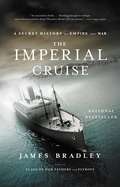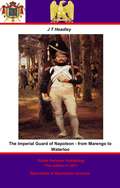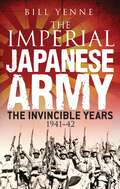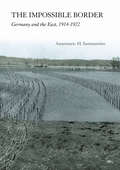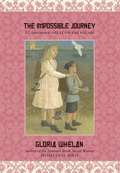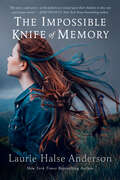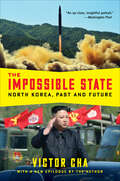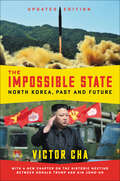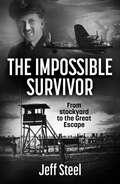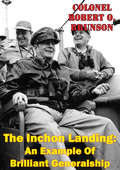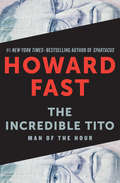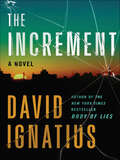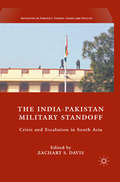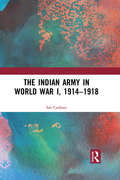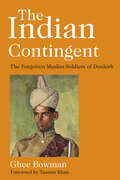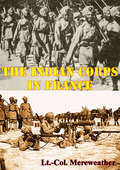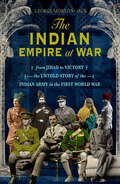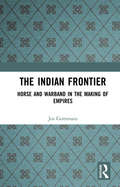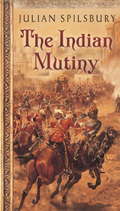- Table View
- List View
The Imperial Cruise: A True Story of Empire and War
by James BradleyIn 1905 President Teddy Roosevelt dispatched Secretary of War William Howard Taft on the largest U.S. diplomatic mission in history to Hawaii, Japan, the Philippines, China, and Korea. Roosevelt's glamorous twenty-one-year-old daughter Alice served as mistress of the cruise, which included senators and congressmen. On this trip, Taft concluded secret agreements in Roosevelt's name. In 2005, a century later, James Bradley traveled in the wake of Roosevelt's mission and discovered what had transpired in Honolulu, Tokyo, Manila, Beijing and Seoul. In 1905, Roosevelt was bully-confident and made secret agreements that he though would secure America's westward push into the Pacific. Instead, he lit the long fuse on the Asian firecrackers that would singe America's hands for a century.
The Imperial German Army Between Kaiser and King: Monarchy, Nation-Building, and War, 1866-1918
by Gavin WiensThis book provides a reappraisal of Germany’s military between the mid-nineteenth century and the end of the First World War. At its core is the following question: how 'German' was the imperial German army? This army, which emerged from the Wars of Unification in 1871, has commonly been seen as the 'school of the nation'. After all – so this argument goes – tens of thousands of young men passed through its ranks each year, with conscripts undergoing an intense program of patriotic education and returning to civilian life as fervent German nationalists and ardent supporters of the German emperor, or Kaiser. This book reexamines this assumption. It does not deny that devotion to the Fatherland and loyalty to the Kaiser were widespread among German soldiers in the decades following unification. It nevertheless shows that the imperial German army was far less homogenous and far more faction-ridden than has hitherto been acknowledged.
The Imperial Guard of Napoleon - from Marengo to Waterloo
by Pickle Partners Publishing Joel Tyler HeadleyThis ebook is purpose built and is proof-read and re-type set from the original to provide an outstanding experience of reflowing text for an ebook reader. J. T. Headley was born at the very end of the convulsive period of the French revolution and Napoleonic Wars that followed, and wrote a number of volumes on the French army and its leadership of the period. This volume is a short and pithy, none the less entertaining, account of the structure, growth and battles of the famed Garde Impériale of Napoleon. Starting with the formation of the Guard from the early days in its form as the Consular Guard and their baptism of fire at Marengo. In the words of Napoleon - It was Granite Column: (Words of the First Consul in his report on the battle of Marengo to the government, 27 Prairial year VII.) Headley charts the growth of a corps of a few thousand men to an army within an army from 1812 onward until their final heroic stand at Waterloo to their disbandment by the Bourbon monarchy. Leaders such as Bessières and Drouot are picked out in detail, and famous events are described with panache. The volume leans heavily on Emile Marco St-Hilaire's Histoire anecdotique, politique et militaire de la Garde impériale Paris, Penaud, 1845-47, but is none the worst for it. A jaunty read. Text taken, whole and complete, from the 1851 edition published in New York by Charles Scribner. Original 310 pages. Author - Joel Tyler Headley (30/12/1813 - 30/12/1897)
The Imperial Japanese Army
by Bill YenneThe German blitzkrieg stunned the world in 1939-1940, and so too did the Japanese "blitzkrieg" of 1941-1942 in the Philippines, Indonesia, Malaya, and Burma. However, the remarkable Japanese land offensive involving operations of equivalent scope and complexity has received only a fraction of the attention. This is the story of that campaign.One of the few histories that tells the story of the Pacific War from the Japanese side, this is the long-awaited overview of the years when the Imperial Japanese Army (IJA) was conducting its seemingly unstoppable ground campaign in the Far East. It includes extensive background and biographical information on Japanese commanders, including Homma and Yamashita. In just eight weeks following December 7, 1941, the IJA pushed the Americans out of the Philippines, and defeated the British to captured Manila, Hong Kong, the Malay Peninsula, and the great bastion at Singapore--called the "Gibraltar of the East." They also forced the capitulation and occupation of Siam and the occupation of Burma. A month later, the Japanese had added the Netherlands East Indies, with an area and depth of natural resources more than twice that of Japan, to their trophy case. In The Imperial Japanese Army, author Bill Yenne recounts how the IJA faced and surmounted technical challenges that the Wehrmacht did not have--transportation. Whereas most of the German conquests were reachable by highways or rail lines, all of the IJA operations required ship transport, and most required amphibious landings. For example, in the Malay Peninsula campaign, the IJA famously used bicycles for the drive on Singapore.Unlike most histories of the Pacific War that focus on the Allied experience, The Imperial Japanese Army examines the year of victory from the Japanese perspective, when the mighty Japanese naval and ground forces swept all before them both throughout the Pacific and on mainland Asia.
The Imperial Japanese Navy in the Pacific War
by Mark StilleFrom the stunning victory at Pearl Harbor to its dramatic reversal at Midway, the Imperial Japanese Navy swept all before it in its numerous victories in the Pacific and Far Eastern waters. The Imperial Japanese Navy in the Pacific War pulls from many of Osprey's bestselling books on the subject in addition to the most recent research on the subject, including many sources from Japan, and is the most recent and accurate book on this fascinating force.Even after its setback at midway, the IJN remained a powerful force and inflicted sever setbacks on the US Navy at Guadalcanal and elsewhere. The Imperial Japanese Navy focuses on the Japanese ships which fought the battles in the Pacific including design details, where and when they were engaged and their ultimate effectiveness. In addition, the construction, design and service history of each ship from destroyer size on up is included. A comprehensive survey of the submarine force is also included. Modifications of each ship are covered making this a valuable reference source for Pacific War enthusiasts and historians, as well as ship modelers.A short history of the IJN during the Pacific War places all warship design and history in proper context. Finally, a chapter discussing the strengths and weaknesses of the IJN is included ultimately asking the question of whether the IJN really was a modern Navy which was fully prepared for the rigors of combat in the Pacific.
The Impossible Border: Germany and the East, 1914-1922
by Annemarie H. SammartinoBetween 1914 and 1922, millions of Europeans left their homes as a result of war, postwar settlements, and revolution. After 1918, the immense movement of people across Germany's eastern border posed a sharp challenge to the new Weimar Republic. Ethnic Germans flooded over the border from the new Polish state, Russian emigres poured into the German capital, and East European Jews sought protection in Germany from the upheaval in their homelands. Nor was the movement in one direction only: German Freikorps sought to found a soldiers' colony in Latvia, and a group of German socialists planned to settle in a Soviet factory town. In The Impossible Border, Annemarie H. Sammartino explores these waves of migration and their consequences for Germany. Migration became a flashpoint for such controversies as the relative importance of ethnic and cultural belonging, the interaction of nationalism and political ideologies, and whether or not Germany could serve as a place of refuge for those seeking asylum. Sammartino shows the significance of migration for understanding the difficulties confronting the Weimar Republic and the growing appeal of political extremism. Sammartino demonstrates that the moderation of the state in confronting migration was not merely by default, but also by design. However, the ability of a republican nation-state to control its borders became a barometer for its overall success or failure. Meanwhile, debates about migration were a forum for political extremists to develop increasingly radical understandings of the relationship between the state, its citizens, and its frontiers. The widespread conviction that the democratic republic could not control its "impossible" Eastern borders fostered the ideologies of those on the radical right who sought to resolve the issue by force and for all time.
The Impossible Journey
by Gloria WhelanOne Russian night in 1934, Marya and Georgi's parents disappear. Despite high risks, Katya and Misha had spoken against the government. The children, alone and desperate, fear the worst. Will they ever see their parents again? But all it takes is one crumpled letter to give Marya and Georgi hope and send them on a dangerous mission to reunite their family. They must steal away in the dark of night, escape the city, and find passage to the great Siberian wilderness. And even then, if they succeed in getting away, their journey will have only just begun. In this companion novel to her breathtaking Russian epic Angel on the Square, National Book Award winning author Gloria Whelan takes readers on a remarkable journey that is both perilous and transforming.
The Impossible Knife of Memory
by Laurie Halse Anderson<P>For the past five years, Hayley Kincaid and her father, Andy, have been on the road, never staying long in one place as he struggles to escape the demons that have tortured him since his return from Iraq. <P>Now they are back in the town where he grew up so Hayley can attend school. <P>Perhaps, for the first time, Hayley can have a normal life, put aside her own painful memories, even have a relationship with Finn, the hot guy who obviously likes her but is hiding secrets of his own. <P>Will being back home help Andy's PTSD, or will his terrible memories drag him to the edge of hell, and drugs push him over?
The Impossible State: North Korea, Past and Future
by Victor ChaFrom a seasoned advisor, &“a meaty, fast-paced portrait of North Korean society, economy, politics and foreign policy&” (Foreign Affairs). In The Impossible State, international-policy expert and former Director for Asian Affairs at the National Security Council Victor Cha pulls back the curtain on this controversial and isolated country, providing the best look yet at North Korea&’s history, the rise of the Kim family dynasty, and the obsessive personality cult that empowers them. He illuminates the repressive regime's complex economy and culture, its appalling record of human-rights abuses, and its belligerent relationship with the United States, and analyzes the regime&’s major security issues—from the seemingly endless war with its southern neighbor to its frightening nuclear ambitions—all in light of the destabilizing effects of Kim Jong-il's death and the pivotal and disquieting transition of power from tyrannical father to inexperienced son. How this enigmatic nation-state—one that regularly violates its own citizens&’ inalienable rights and has suffered famine, global economic sanctions, a collapsed economy, and near total isolation from the rest of the world—has continued to survive has long been a question that preoccupies the West. Cha reveals a land of contradictions, and delves into the ideology that leads an oppressed, starving populace to cling so fiercely to its failed leadership. With rare personal anecdotes from the author&’s time in Pyongyang and his tenure as an adviser in the White House, this authoritative, accessible, &“engrossing&” history (The Economist) offers much-needed understanding of the country&’s veiled past and uncertain future. &“An up-close, insightful portrait.&” —The Washington Post &“An eye-opening view of the closed, repressive dictatorship of North Korea. . . . A useful, pertinent work for understanding the human story behind the headlines.&” —Kirkus Reviews
The Impossible State: North Korea, Past and Future
by Victor ChaIn The Impossible State, seasoned international-policy expert and lauded scholar Victor Cha pulls back the curtain on provocative, isolationist North Korea, providing our best look yet at its history and the rise of the Kim family dynasty and the obsessive personality cult that empowers them. Cha illuminates the repressive regime’s complex economy and culture, its appalling record of human rights abuses, and its belligerent relationship with the United States, and analyzes the regime’s major security issues—from the seemingly endless war with its southern neighbor to its frightening nuclear ambitions—all in light of the destabilizing effects of Kim Jong-il’s death and the transition of power to his unpredictable heir.Ultimately, this engagingly written, authoritative, and highly accessible history warns of a regime that might be closer to its end than many might think—a political collapse for which America and its allies may be woefully unprepared.
The Impossible Survivor: From stockyard to the Great Escape
by Jeff SteelNothing can prepare a man for the horrors of war, nor the haunting memories that linger long after the battle is over. In The Impossible Survivor, Jeff Steel invites readers into the life of Neil Lindsay, a retired RAF Bomber Command veteran, as he confronts the shadows of his past. On a seemingly ordinary day in 1995, Neil and his daughter Margaret visit a memorial honouring the fallen soldiers of the Goulburn Valley. What begins as a simple outing soon unravels the buried truths of Neil&’s harrowing experiences during World War II. An ambitious young man, Neil's fate intertwined with the legendary figures of the RAF, including the celebrated Wing Commander Guy Gibson. He bravely flew perilous missions over Nazi Germany, becoming the sole survivor of a downed bomber and enduring two years of torment in a German prisoner-of-war camp. As he stands before the memorial stone he provides a glimpse into his past, sharing the first fragments of the extraordinary story that had been hidden for so long.The Impossible Survivor is a powerful tribute to those who fought bravely, capturing the essence of ordinary men faced with extraordinary circumstances. These men did not seek out the risk of death or the challenges of war; they volunteered out of a sense of duty and courage. They faced life-or-death situations with a blend of character, training, determination, and a touch of luck, fully aware of the slim chances of returning home. Neil Lindsay&’s story stands as a powerful testament to their extraordinary resolve.
The In & Out
by Tim NewarkThe Naval and Military Club--or the 'In & Out' as it is affectionately known--is one of Britain's greatest and oldest service clubs and this book tells its rich and entertaining history for the first time. Lavishly illustrated, it captures the essence of British style inside one of London's grandest clubhouses--first with a famous home in Piccadilly and now in St James's Square. Over 150 years, its members have included numerous Victoria Cross winners, triumphant generals and admirals, even bold explorers. There are intimate tales of brave soldiers and sailors--alongside a few rogues and accounts of scandalous behaviour!
The Inchon Landing: An Example Of Brilliant Generalship
by Colonel Robert O. BrunsonThe Inchon Landing’s success required a commander like General MacArthur who could gain the cooperation and coordination of the Army, Navy, Marine, and Air Force commanders, despite their belief that the Inchon Landing operation was very nearly impossible. Only these commanders, with their men, had the necessary experience in amphibious attacks under General MacArthur in the Pacific during World War II. The speed at which the forces were built up, the timely and accurate intelligence information gathered, and the brave and valiant execution of the plan by the soldiers, sailors, airmen, and marines who successfully fought not just the enemy forces but also the natural characteristics of the landing site with its tides, seawalls, mud flats and monsoons; changed the very nature of the Korean conflict. The landing at Inchon cut the North Korean lines of communication, allowed the breakout of the Pusan Perimeter, and totally routed Communist forces on the brink of apparent victory. The amphibious landing at Inchon on 15 September 1950, with its flanking movement using the indirect approach, is truly an example of brilliant generalship and military genius.
The Incredible Tito: Man of the Hour
by Howard FastFast&’s fascinating biography of Joseph Broz, known to the world as Tito, including his rise to power and his remarkable stand against fascismThe world was mired in the Second World War when Howard Fast wrote The Incredible Tito. Upon the book&’s publication in 1944, there was still no united Yugoslavia, the Axis controlled most of Europe, and D-Day was only in the planning stages. In the Balkans, Tito was a beacon of hope against the advancing Nazis. He led a force of resistance fighters that bedeviled the occupying German army throughout Slavic regions and empowered people&’s committees to act as local government in all liberated areas. For observers on the political left, Tito seemed uniquely poised to unite the East and West against fascism—once and for all. This ebook features an illustrated biography of Howard Fast including rare photos from the author&’s estate.
The Increment
by David IgnatiusFrom a hidden enclave in the maze of Tehran, an Iranian scientist who calls himself "Dr. Ali" sends an encrypted message to the CIA. It falls to Harry Pappas to decide if it's for real. Dr. Ali sends more secrets of the Iranian bomb program to the agency, then panics. He's being followed, but he doesn't know who's onto him, and neither does Pappas. The White House is no help -- they're looking for a pretext to attack Tehran. To get his agent out, Pappas turns to a secret British spy team known as "The Increment," whose operatives carry the modern version of the double-0 "license to kill." But the real story here is infinitely more complicated than he understands, and to get to the bottom of it, he must betray his own country. The Increment is The Spy Who Came In from the Cold set in Iran, with a dose of Graham Greene's The Human Factor to highlight the subtleties of betrayal.
The Increment: A Novel
by David IgnatiusThe New York Times bestseller: “A remarkably timely and pulse-quickening tale of deception, divided loyalty, and moral haziness.”—Raleigh News & Observer Harry Pappas, chief of the CIA’s Persia House, receives an encrypted message from a scientist in Tehran. But soon the source of secrets from the Iranian bomb program dries up: the scientist panics; he’s being followed, but he doesn’t know who’s on to him, and neither does Harry. To get his agent out, Harry turns to a secret British spy team known as “The Increment,” whose operatives carry the modern version of the double-O “license to kill.” But the real story is infinitely more complicated than Harry understands, and to get to the bottom of it he must betray his own country.
The India-Pakistan Military Standoff
by Zachary S. DavisThis book focuses on the 2001-2002 crisis that brought India and Pakistan to the brink of war. Authors focus on: the political history that led to the crisis; the conventional military environment, the nuclear environment and coercive diplomacy and de-escalation during the crisis; and how South Asia can avoid similar crises in the future.
The Indian Army and the End of the Raj
by Daniel MarstonThe Partition of British India in 1947 resulted in the establishment of the independent states of India and Pakistan and the end of the British Raj. The decision to divide British India along religious lines led to widespread upheaval and communal violence in the period leading up to and following the official day of independence, 15 August 1947. In this book, Daniel Marston provides a unique examination of the role of the Indian army in post-World War II India. He draws upon extensive research into primary source documents and interviews with veterans of the events of 1947 to provide fresh insight into the vital part that the Indian Army played in preserving law and order in the region. This rigorous book fills a significant gap in the historiography of the British in India and will be invaluable to those studying the British Empire and South Asia more generally.
The Indian Army in World War I, 1914-1918
by Ian CardozoThis volume recounts India’s contribution to World War I. Please note: Taylor & Francis does not sell or distribute the Hardback in India, Pakistan, Nepal, Bhutan, Bangladesh and Sri Lanka
The Indian Army on the Western Front
by George Morton-JackThe Indian army fought on the Western Front with the British Expeditionary Force (BEF) from 1914 to 1918. Traditional interpretations of its performance have been dominated by ideas that it was a failure. This book offers a radical reconsideration by revealing new answers to the questions that have been central to the debate, such as whether the Indian army 'saved' the BEF from defeat in 1914, or whether Indian troops were particularly prone to self-inflict wounds and to flee the trenches. It looks at the Indian army from top to bottom, from generals at headquarters to snipers in no man's land. It takes a global approach, exploring the links between the Indian army's 1914-18 campaigning in France and Belgium and its pre-1914 small wars in Asia and Africa, and comparing the performance of the Indian regiments on the Western Front to those in China, east Africa, Mesopotamia, Gallipoli and elsewhere.
The Indian Contingent: The Forgotten Muslim Soldiers of Dunkirk
by Ghee Bowman‘An incredible and important story, finally being told’ Mishal Husain‘Groundbreaking ... a riveting and moving account’ Yasmin KhanOn 28 May 1940, Major Akbar Khan marched at the head of 299 soldiers along a beach in northern France. They were the only Indians in the British Expeditionary Force at Dunkirk. With Stuka sirens wailing, shells falling in the water and Tommies lining up to be evacuated, these soldiers of the British Indian Army, carrying their disabled imam, found their way to the East Mole and embarked for England in the dead of night. On reaching Dover, they borrowed brass trays and started playing Punjabi folk music, upon which even ‘many British spectators joined in the dance’. What journey had brought these men to Europe? What became of them – and of comrades captured by the Germans? With the engaging style of a true storyteller, Ghee Bowman reveals in full, for the first time, the astonishing story of the Indian Contingent, from their arrival in France on 26 December 1939 to their return to an India on the verge of partition. It is one of the war’s hidden stories that casts fresh light on Britain and its empire.
The Indian Corps In France [Illustrated Edition]
by Lt.-Col. John Walter Beresford Merewether Frederick Edwin Smith Earl of BirkenheadIncludes 24 portraits, maps and plans."The only history of the Indian Corps in France in the Great War, from 1914 to 1915 when the Corps transferred to the Middle East. A fascinating story.The Indian Corps, consisting of two infantry divisions (Meerut and Lahore), arrived in France in September/October 1914. It was commanded by Lieutenant-General Sir James Willcocks who was the most senior officer in the BEF after Field Marshal Sir John French and General Sir Horace Smith-Dorrien. The corps remained on the Western Front till the end of 1915, when it was transferred to the Middle East, a more suitable theatre of war for Indian Army troops. This history was published at the request and under the authority of the India Office, and apart from General Willcocks' own memoirs, With The Indians in France, it is the only record of the corps. It is not altogether a happy tale, as the book makes clear. While there was no questioning the bravery of the troops (five Indian/Gurkha VCs) there were problems of climate, reinforcements, officer casualties (the Indian battalion had only 13 British officers, who were first priority targets for the Germans), not to mention mishandling and lack of understanding on the part of the High Command. Total casualties among Indian Army units amounted to 21,413 (each division had, initially, three British battalions and divisional artillery was British). An unusual and fascinating story and history."-Print Ed.
The Indian Empire At War: From Jihad to Victory, The Untold Story of the Indian Army in the First World War
by George Morton-Jack'Essential to a proper understanding of the war and of our world of today' Michael Morpurgo1.5 million Indians fought with the British in the First World War - from Flanders to the African bush and the deserts of the Islamic world, they saved the Allies from defeat in 1914 and were vital to global victory in 1918. Using previously unpublished veteran interviews, this is their story, told as never before.
The Indian Frontier: Horse and Warband in the Making of Empires
by Jos GommansThis omnibus brings together some old and some recent works by Jos Gommans on the warhorse and its impact on medieval and early modern state-formation in South Asia. These studies are based on Gommans’ observation that Indian empires always had to deal with a highly dynamic inner frontier between semi-arid wilderness and settled agriculture. Such inner frontiers could only be bridged by the ongoing movements of Turkish, Afghan, Rajput and other warbands. Like the most spectacular examples of the Delhi Sultanate and the Mughal Empires, they all based their power on the exploitation of the most lethal weapon of that time: the warhorse. In discussing the breeding and trading of horses and their role in medieval and early modern South Asian warfare, Gommans also makes some thought-provoking comparisons with Europe and the Middle East. Since the Indian frontier is part of the much larger Eurasian Arid Zone that links the Indian subcontinent to West, Central and East Asia, the final essay explores the connected and entangled history of the Turko-Mongolian warband in the Ottoman and Timurid Empires, Russia and China.
The Indian Mutiny
by Julian SpilsburyAn epic true story of treachery, revenge and courageThe Indian Mutiny is a real page-turner, an epic story with surprising modern parallels. Fomer army officer-turned-TV scriptwriter, Julian Spilsbury is the ideal author to take us back to the desperate summer of 1857 when thousands of Indian soldiers mutinied. They murdered their officers, hunted down the women and children and burned and slaughtered their way to Delhi. The tiny British garrison at Lucknow held out against all odds; the one at Cawnpore surrendered only to be betrayed and massacred.Modern Indian accounts call this 'the first war of liberation', but as Julian Spilsbury reveals, 80 per cent of the so-called 'British' forces were from the sub-continent. Sikhs, Gurkhas and Afghans fought alongside small numbers of British soldiers. Together, they faced terrible odds and won. In the process they created a new army that would play a vital role in the Allied forces in both World Wars. Julian Spilsbury weaves the story together from some of the most vivid eyewitness accounts ever written. From the women and children hiding from blood-crazed mobs, to the epic battles that decided the campaign, to the grisly revenge exacted by the British forces, this is a gripping recreation of the greatest crisis of Empire.
